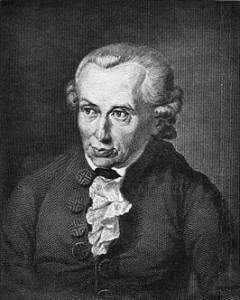The Critique of Pure Reason is a long and intricate text. Most of what I discussed in Parts I and II is material covered just in the Introduction! In this final installment of our Kant series, we’ll briefly discuss the first formal section of the CPR, the Transcendental Aesthetic, where Kant elucidates his radical view of space and time. Also, from a later section of the critique, we will examine Kant’s notion of the transcendental synthetic unity of apperception, and I will argue that he is essentially talking about Atman in Western philosophical terms. Continue reading
Author Archives: Charles
The Relevance of Kant’s Transcendental Idealism to Advaita Vedanta, Part II
 In Part I of this three-part series, I introduced Kant’s work and summarized his views on a priori and a posteriori knowledge. In this second part, we’ll review analytic versus synthetic judgments, clarify the meaning of transcendental idealism as it applies to Kant’s work in general, and also analyze tat tvam asi in terms of Kant’s philosophy.
In Part I of this three-part series, I introduced Kant’s work and summarized his views on a priori and a posteriori knowledge. In this second part, we’ll review analytic versus synthetic judgments, clarify the meaning of transcendental idealism as it applies to Kant’s work in general, and also analyze tat tvam asi in terms of Kant’s philosophy.
Analytic and Synthetic Judgments
Kant’s investigation of the faculties of reason led him to explore the nature of judgments. He made clear the crucial difference between analytic and synthetic judgments. Kant’s jargon can become admittedly arcane, but analytic and synthetic are not hard to understand. Continue reading
The Relevance of Kant’s Transcendental Idealism to Advaita Vedanta, Part I
This the first of a three-part series discussing the relevance of Kant’s philosophy to Advaita. 
Immanuel Kant published the first edition of The Critique of Pure Reason in 1781, with an extensively rewritten second edition appearing in 1787. Between those editions he also published a shorter “easier” introduction to his philosophy, Prolegomena to Any Future Metaphysics (1783). With the later appearance of The Critique of Practical Reason (1788) and The Critique of Judgement (1790), Kant had articulated a complete system of philosophy of incredible depth and complexity, wholly original and unique in its solution to the age-old problems of reason, ethics, and logic. So great was the importance of this Prussian professor, we may justifiably think in terms of pre-Kantian and post-Kantian philosophy. Many have disagreed with his conclusions and offered refutations on one level or another, but all who have come after Kant have been required to address him. Continue reading
Teasing Apart Maya’s Tricks – Black Hole Complementarity and Observer-Dependent Reality
 This article was previously published in two parts on the Beyond Advaita blog maintained by our Dr. Ramesam Vemuri, in continuation of an ongoing series of articles exploring the relevance to Advaita of some of the latest research in theoretical physics. Science is converging to a view that no description of reality can be complete without the observer, and that so-called “objective reality” is really more of a holographic illusion than anything truly solid or substantial. Today’s scientists are busy trying to tease apart Maya’s tricks to see how this illusion works. Leonard Susskind’s theory of Black Hole Complementarity (BHC) — the topic of this article — provides a good example of this driving curiosity in action.
This article was previously published in two parts on the Beyond Advaita blog maintained by our Dr. Ramesam Vemuri, in continuation of an ongoing series of articles exploring the relevance to Advaita of some of the latest research in theoretical physics. Science is converging to a view that no description of reality can be complete without the observer, and that so-called “objective reality” is really more of a holographic illusion than anything truly solid or substantial. Today’s scientists are busy trying to tease apart Maya’s tricks to see how this illusion works. Leonard Susskind’s theory of Black Hole Complementarity (BHC) — the topic of this article — provides a good example of this driving curiosity in action.
Reflections on Body-Mind and Liberation
 There has been much healthy debate recently on the Advaita Vision Blog about Liberation, who or what is a jnani or jivanmukta, and what it means to follow traditional Advaita. The theme of this post is that we cannot resolve such questions without first gaining a clear understanding of the body-mind and its role in the context of Liberation. What follows are some reflections inspired by a spirited discussion with Ramesam, with due credit to him for stimulating many of the thoughts below. Any errors or possible misunderstandings are entirely my fault. Or perhaps not, since “Words fall back from it.” Continue reading
There has been much healthy debate recently on the Advaita Vision Blog about Liberation, who or what is a jnani or jivanmukta, and what it means to follow traditional Advaita. The theme of this post is that we cannot resolve such questions without first gaining a clear understanding of the body-mind and its role in the context of Liberation. What follows are some reflections inspired by a spirited discussion with Ramesam, with due credit to him for stimulating many of the thoughts below. Any errors or possible misunderstandings are entirely my fault. Or perhaps not, since “Words fall back from it.” Continue reading

